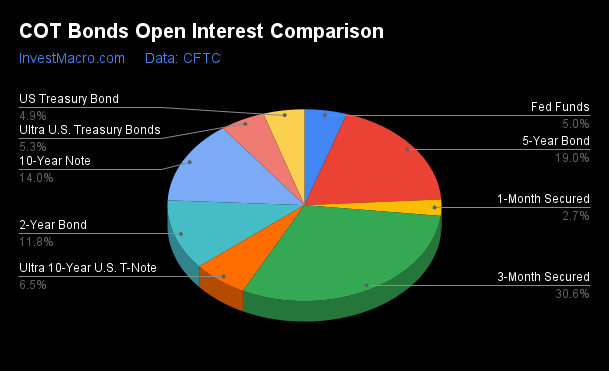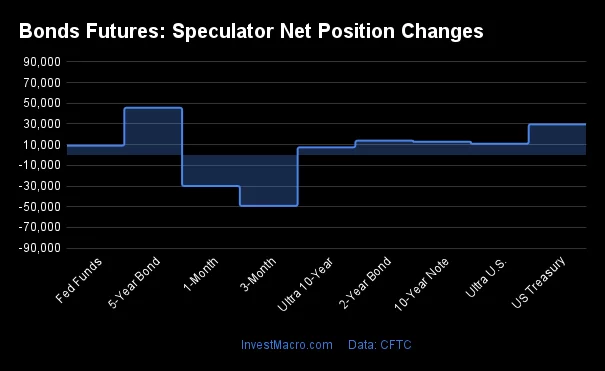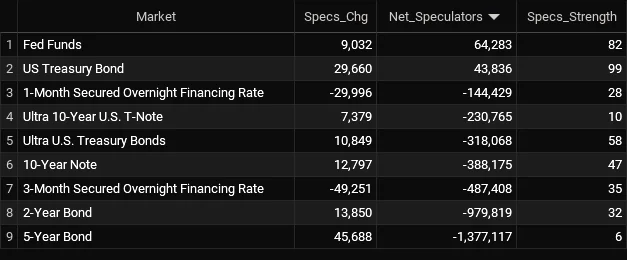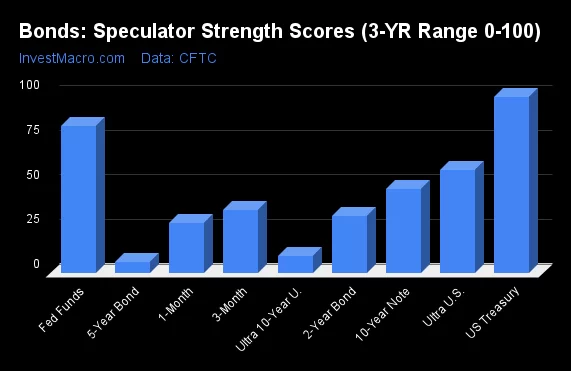By InvestMacro
Here are the latest charts and statistics for the Commitment of Traders (COT) reports data published by the Commodities Futures Trading Commission (CFTC).
The latest COT data is updated through Tuesday May 28th and shows a quick view of how large traders (for-profit speculators and commercial hedgers) were positioned in the futures markets.
Weekly Speculator Changes led by 5-Year Bonds & US Treasury Bonds
The COT bond market speculator bets were higher this week as seven out of the eight bond markets we cover had higher positioning while the other one markets had lower speculator contracts.
Free Reports:
 Get our Weekly Commitment of Traders Reports - See where the biggest traders (Hedge Funds and Commercial Hedgers) are positioned in the futures markets on a weekly basis.
Get our Weekly Commitment of Traders Reports - See where the biggest traders (Hedge Funds and Commercial Hedgers) are positioned in the futures markets on a weekly basis.
 Sign Up for Our Stock Market Newsletter – Get updated on News, Charts & Rankings of Public Companies when you join our Stocks Newsletter
Sign Up for Our Stock Market Newsletter – Get updated on News, Charts & Rankings of Public Companies when you join our Stocks Newsletter
Leading the gains for the bond markets was the 5-Year Bonds (45,688 contracts) with the US Treasury Bonds (29,660 contracts), the 2-Year Bonds (13,850 contracts), the 10-Year Bonds (12,797 contracts),the Ultra Treasury Bonds (10,849 contracts), the Fed Funds (9,032 contracts) and with the Ultra 10-Year Bonds (7,379 contracts) also showing a positive week.
The only bond market with a decline in speculator bets was the SOFR 3-Months with a decrease of -49,251 contracts on the week.
Bonds Net Speculators Leaderboard
Legend: Weekly Speculators Change | Speculators Current Net Position | Speculators Strength Score compared to last 3-Years (0-100 range)
Strength Scores led by US Treasury Bonds & Fed Funds
COT Strength Scores (a normalized measure of Speculator positions over a 3-Year range, from 0 to 100 where above 80 is Extreme-Bullish and below 20 is Extreme-Bearish) showed that the US Treasury Bonds (99 percent) and the Fed Funds (82 percent) lead the bond markets this week. The Ultra Treasury Bonds (58 percent) comes in as the next highest in the weekly strength scores.
On the downside, the 5-Year Bonds (6 percent) and the Ultra 10-Year Bonds (10 percent) come in at the lowest strength level currently and are in Extreme-Bearish territory (below 20 percent). The next lowest strength scores were the 2-Year Bonds (32 percent) and the SOFR 3-Months (35 percent).
Strength Statistics:
Fed Funds (82.3 percent) vs Fed Funds previous week (80.4 percent)
2-Year Bond (31.7 percent) vs 2-Year Bond previous week (30.8 percent)
5-Year Bond (5.9 percent) vs 5-Year Bond previous week (2.9 percent)
10-Year Bond (46.8 percent) vs 10-Year Bond previous week (45.6 percent)
Ultra 10-Year Bond (9.6 percent) vs Ultra 10-Year Bond previous week (8.1 percent)
US Treasury Bond (98.8 percent) vs US Treasury Bond previous week (88.4 percent)
Ultra US Treasury Bond (57.6 percent) vs Ultra US Treasury Bond previous week (53.1 percent)
SOFR 3-Months (35.1 percent) vs SOFR 3-Months previous week (37.6 percent)
US Treasury Bonds & Fed Funds top the 6-Week Strength Trends
COT Strength Score Trends (or move index, calculates the 6-week changes in strength scores) showed that the US Treasury Bonds (21 percent) leads the past six weeks trends for bonds. The Fed Funds (1 percent) are the next highest positive mover in the latest trends data.
The SOFR 3-Months (-19 percent), the 5-Year Bonds (-12 percent) and the Ultra Treasury Bonds (-10 percent) lead the downside trend scores currently.
Strength Trend Statistics:
Fed Funds (1.2 percent) vs Fed Funds previous week (18.4 percent)
2-Year Bond (-2.1 percent) vs 2-Year Bond previous week (-3.0 percent)
5-Year Bond (-11.7 percent) vs 5-Year Bond previous week (-11.7 percent)
10-Year Bond (-2.4 percent) vs 10-Year Bond previous week (9.9 percent)
Ultra 10-Year Bond (-3.5 percent) vs Ultra 10-Year Bond previous week (-16.0 percent)
US Treasury Bond (20.8 percent) vs US Treasury Bond previous week (31.1 percent)
Ultra US Treasury Bond (-9.7 percent) vs Ultra US Treasury Bond previous week (-13.8 percent)
SOFR 3-Months (-18.6 percent) vs SOFR 3-Months previous week (-33.4 percent)
Secured Overnight Financing Rate (3-Month) Futures:
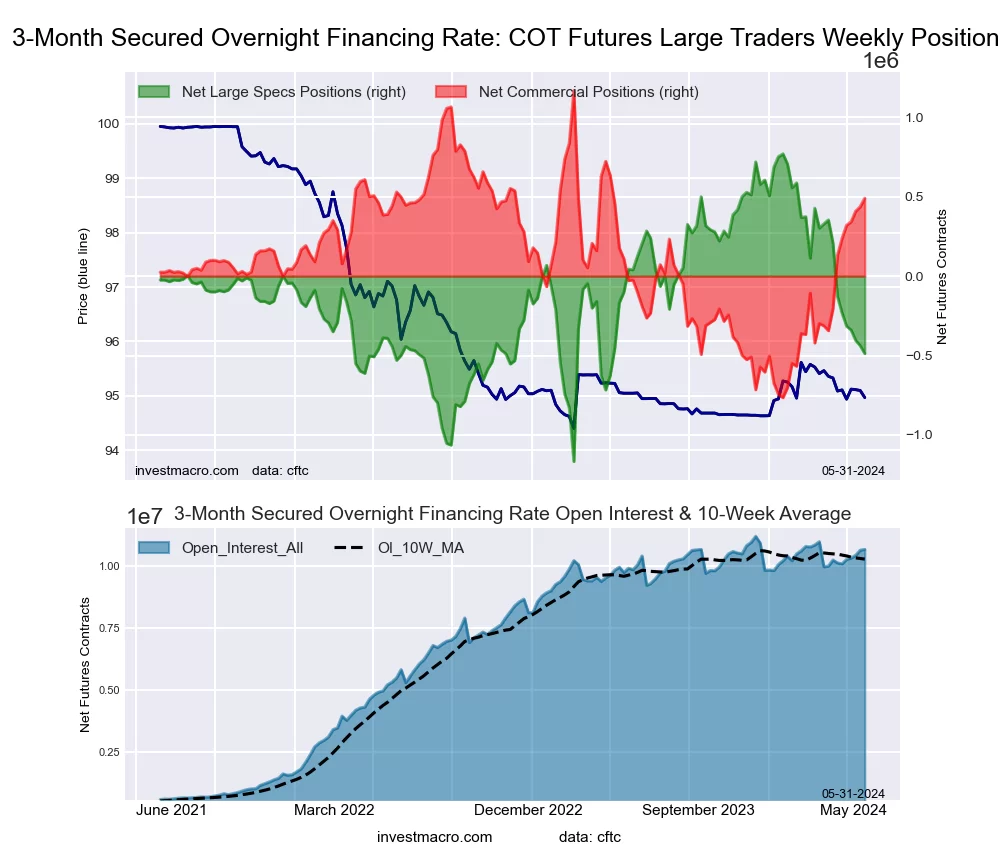 The Secured Overnight Financing Rate (3-Month) large speculator standing this week came in at a net position of -487,408 contracts in the data reported through Tuesday. This was a weekly reduction of -49,251 contracts from the previous week which had a total of -438,157 net contracts.
The Secured Overnight Financing Rate (3-Month) large speculator standing this week came in at a net position of -487,408 contracts in the data reported through Tuesday. This was a weekly reduction of -49,251 contracts from the previous week which had a total of -438,157 net contracts.
This week’s current strength score (the trader positioning range over the past three years, measured from 0 to 100) shows the speculators are currently Bearish with a score of 35.1 percent. The commercials are Bullish with a score of 64.9 percent and the small traders (not shown in chart) are Bullish-Extreme with a score of 86.5 percent.
Price Trend-Following Model: Weak Uptrend
Our weekly trend-following model classifies the current market price position as: Weak Uptrend. The current action for the model is considered to be: Hold – Maintain Long Position.
| SOFR 3-Months Statistics | SPECULATORS | COMMERCIALS | SMALL TRADERS |
| – Percent of Open Interest Longs: | 13.1 | 60.2 | 0.3 |
| – Percent of Open Interest Shorts: | 17.6 | 55.6 | 0.4 |
| – Net Position: | -487,408 | 489,903 | -2,495 |
| – Gross Longs: | 1,397,251 | 6,434,234 | 35,655 |
| – Gross Shorts: | 1,884,659 | 5,944,331 | 38,150 |
| – Long to Short Ratio: | 0.7 to 1 | 1.1 to 1 | 0.9 to 1 |
| NET POSITION TREND: | |||
| – Strength Index Score (3 Year Range Pct): | 35.1 | 64.9 | 86.5 |
| – Strength Index Reading (3 Year Range): | Bearish | Bullish | Bullish-Extreme |
| NET POSITION MOVEMENT INDEX: | |||
| – 6-Week Change in Strength Index: | -18.6 | 18.6 | 0.5 |
30-Day Federal Funds Futures:
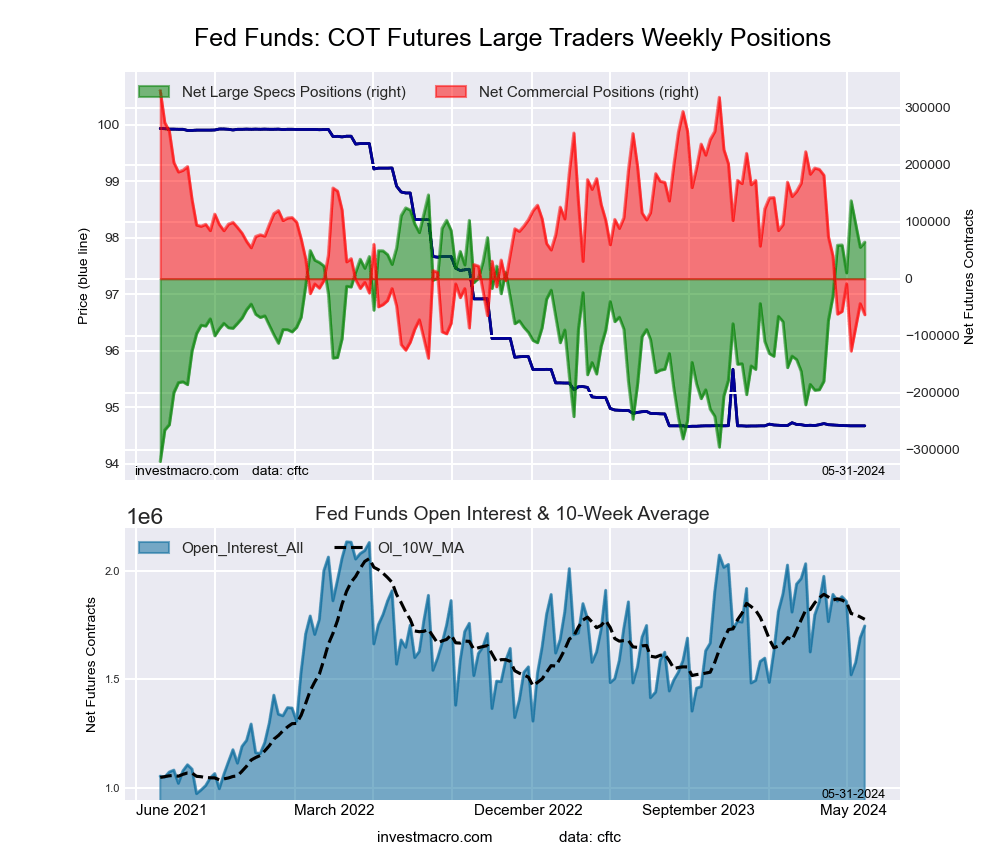 The 30-Day Federal Funds large speculator standing this week came in at a net position of 64,283 contracts in the data reported through Tuesday. This was a weekly rise of 9,032 contracts from the previous week which had a total of 55,251 net contracts.
The 30-Day Federal Funds large speculator standing this week came in at a net position of 64,283 contracts in the data reported through Tuesday. This was a weekly rise of 9,032 contracts from the previous week which had a total of 55,251 net contracts.
This week’s current strength score (the trader positioning range over the past three years, measured from 0 to 100) shows the speculators are currently Bullish-Extreme with a score of 82.3 percent. The commercials are Bearish-Extreme with a score of 16.2 percent and the small traders (not shown in chart) are Bullish-Extreme with a score of 88.9 percent.
Price Trend-Following Model: Downtrend
Our weekly trend-following model classifies the current market price position as: Downtrend. The current action for the model is considered to be: Hold – Maintain Short Position.
| 30-Day Federal Funds Statistics | SPECULATORS | COMMERCIALS | SMALL TRADERS |
| – Percent of Open Interest Longs: | 20.1 | 56.9 | 2.0 |
| – Percent of Open Interest Shorts: | 16.4 | 60.5 | 2.0 |
| – Net Position: | 64,283 | -63,229 | -1,054 |
| – Gross Longs: | 350,244 | 992,025 | 34,238 |
| – Gross Shorts: | 285,961 | 1,055,254 | 35,292 |
| – Long to Short Ratio: | 1.2 to 1 | 0.9 to 1 | 1.0 to 1 |
| NET POSITION TREND: | |||
| – Strength Index Score (3 Year Range Pct): | 82.3 | 16.2 | 88.9 |
| – Strength Index Reading (3 Year Range): | Bullish-Extreme | Bearish-Extreme | Bullish-Extreme |
| NET POSITION MOVEMENT INDEX: | |||
| – 6-Week Change in Strength Index: | 1.2 | -0.2 | -8.7 |
2-Year Treasury Note Futures:
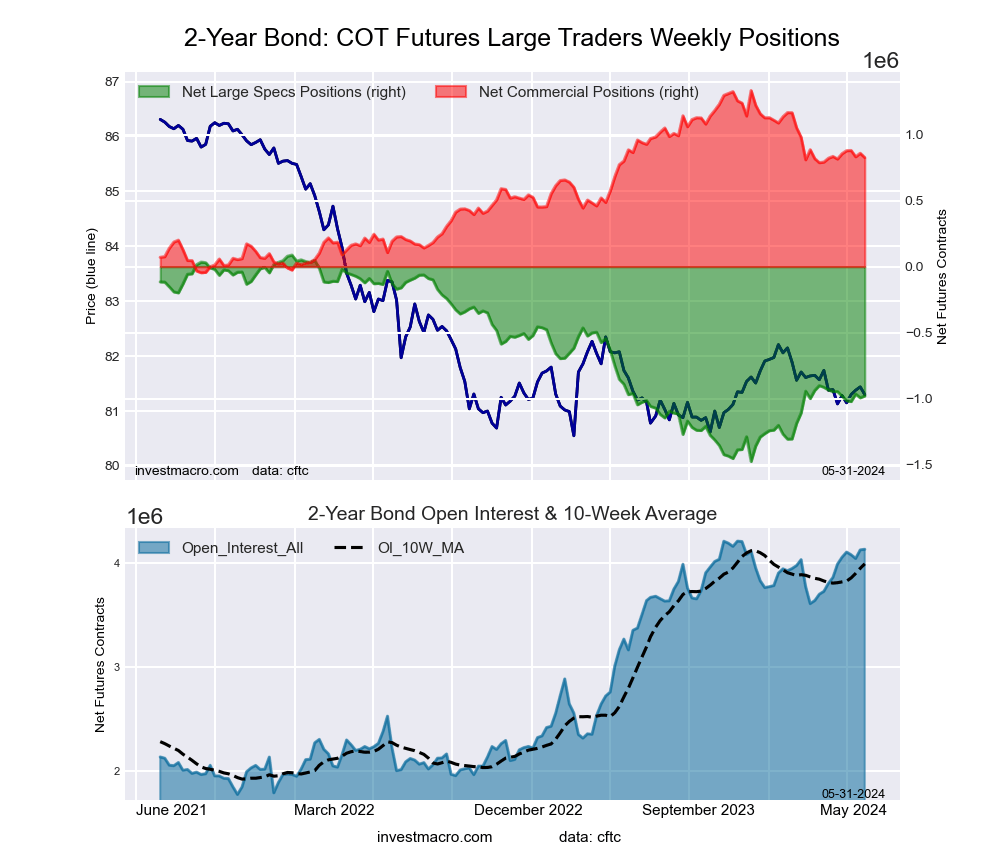 The 2-Year Treasury Note large speculator standing this week came in at a net position of -979,819 contracts in the data reported through Tuesday. This was a weekly lift of 13,850 contracts from the previous week which had a total of -993,669 net contracts.
The 2-Year Treasury Note large speculator standing this week came in at a net position of -979,819 contracts in the data reported through Tuesday. This was a weekly lift of 13,850 contracts from the previous week which had a total of -993,669 net contracts.
This week’s current strength score (the trader positioning range over the past three years, measured from 0 to 100) shows the speculators are currently Bearish with a score of 31.7 percent. The commercials are Bullish with a score of 63.2 percent and the small traders (not shown in chart) are Bullish-Extreme with a score of 100.0 percent.
Price Trend-Following Model: Downtrend
Our weekly trend-following model classifies the current market price position as: Downtrend. The current action for the model is considered to be: Hold – Maintain Short Position.
| 2-Year Treasury Note Statistics | SPECULATORS | COMMERCIALS | SMALL TRADERS |
| – Percent of Open Interest Longs: | 11.8 | 76.9 | 7.7 |
| – Percent of Open Interest Shorts: | 35.5 | 56.9 | 4.0 |
| – Net Position: | -979,819 | 826,543 | 153,276 |
| – Gross Longs: | 488,475 | 3,175,073 | 317,155 |
| – Gross Shorts: | 1,468,294 | 2,348,530 | 163,879 |
| – Long to Short Ratio: | 0.3 to 1 | 1.4 to 1 | 1.9 to 1 |
| NET POSITION TREND: | |||
| – Strength Index Score (3 Year Range Pct): | 31.7 | 63.2 | 100.0 |
| – Strength Index Reading (3 Year Range): | Bearish | Bullish | Bullish-Extreme |
| NET POSITION MOVEMENT INDEX: | |||
| – 6-Week Change in Strength Index: | -2.1 | 0.8 | 8.3 |
5-Year Treasury Note Futures:
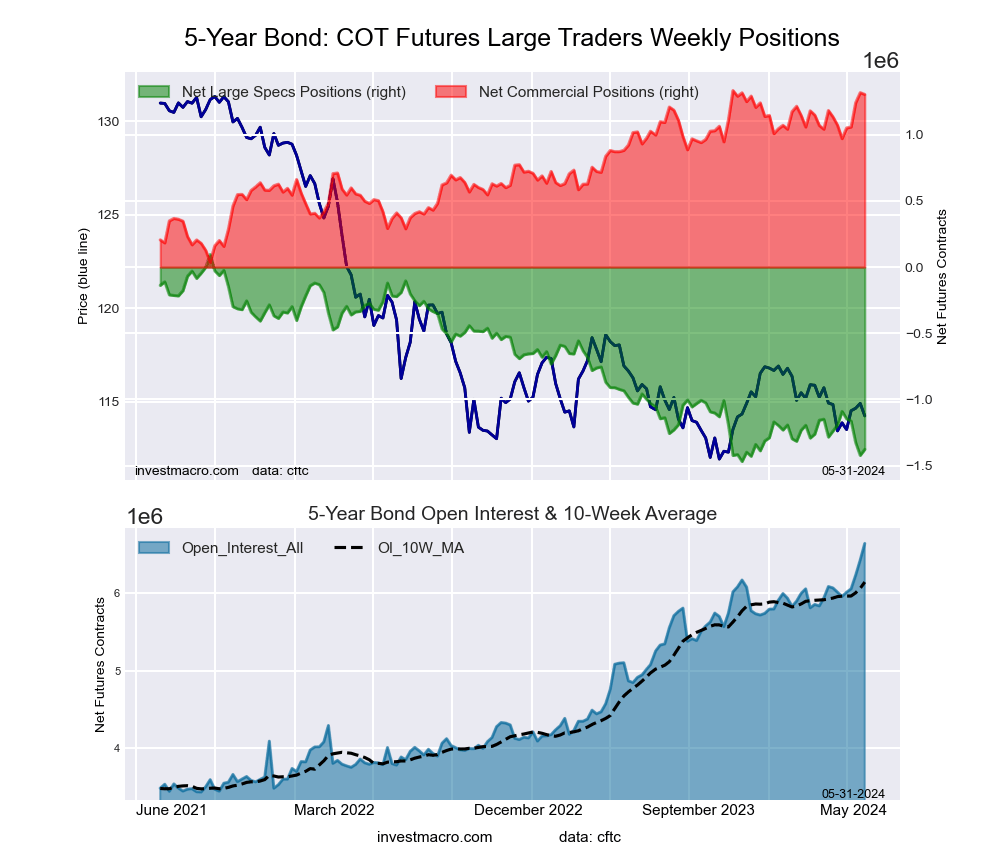 The 5-Year Treasury Note large speculator standing this week came in at a net position of -1,377,117 contracts in the data reported through Tuesday. This was a weekly boost of 45,688 contracts from the previous week which had a total of -1,422,805 net contracts.
The 5-Year Treasury Note large speculator standing this week came in at a net position of -1,377,117 contracts in the data reported through Tuesday. This was a weekly boost of 45,688 contracts from the previous week which had a total of -1,422,805 net contracts.
This week’s current strength score (the trader positioning range over the past three years, measured from 0 to 100) shows the speculators are currently Bearish-Extreme with a score of 5.9 percent. The commercials are Bullish-Extreme with a score of 97.7 percent and the small traders (not shown in chart) are Bullish with a score of 78.1 percent.
Price Trend-Following Model: Downtrend
Our weekly trend-following model classifies the current market price position as: Downtrend. The current action for the model is considered to be: Hold – Maintain Short Position.
| 5-Year Treasury Note Statistics | SPECULATORS | COMMERCIALS | SMALL TRADERS |
| – Percent of Open Interest Longs: | 5.9 | 81.7 | 7.3 |
| – Percent of Open Interest Shorts: | 26.6 | 62.1 | 6.2 |
| – Net Position: | -1,377,117 | 1,304,941 | 72,176 |
| – Gross Longs: | 390,636 | 5,430,187 | 485,314 |
| – Gross Shorts: | 1,767,753 | 4,125,246 | 413,138 |
| – Long to Short Ratio: | 0.2 to 1 | 1.3 to 1 | 1.2 to 1 |
| NET POSITION TREND: | |||
| – Strength Index Score (3 Year Range Pct): | 5.9 | 97.7 | 78.1 |
| – Strength Index Reading (3 Year Range): | Bearish-Extreme | Bullish-Extreme | Bullish |
| NET POSITION MOVEMENT INDEX: | |||
| – 6-Week Change in Strength Index: | -11.7 | 17.9 | -10.5 |
10-Year Treasury Note Futures:
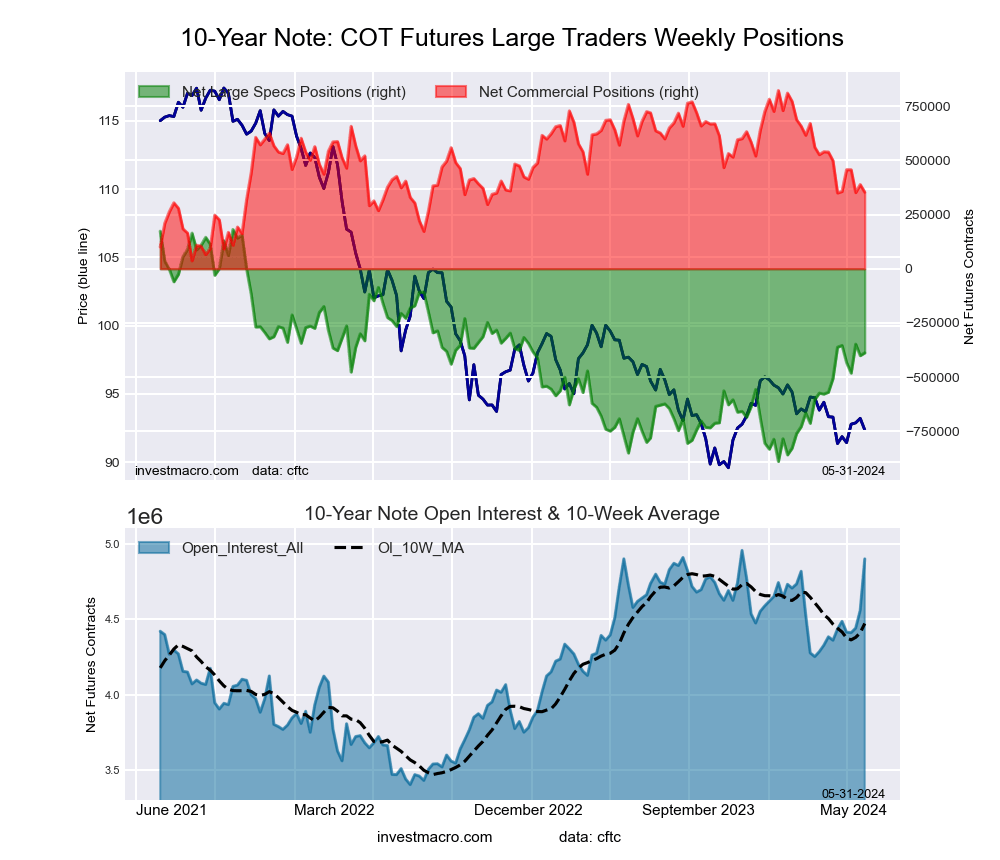 The 10-Year Treasury Note large speculator standing this week came in at a net position of -388,175 contracts in the data reported through Tuesday. This was a weekly advance of 12,797 contracts from the previous week which had a total of -400,972 net contracts.
The 10-Year Treasury Note large speculator standing this week came in at a net position of -388,175 contracts in the data reported through Tuesday. This was a weekly advance of 12,797 contracts from the previous week which had a total of -400,972 net contracts.
This week’s current strength score (the trader positioning range over the past three years, measured from 0 to 100) shows the speculators are currently Bearish with a score of 46.8 percent. The commercials are Bearish with a score of 40.2 percent and the small traders (not shown in chart) are Bullish-Extreme with a score of 81.1 percent.
Price Trend-Following Model: Downtrend
Our weekly trend-following model classifies the current market price position as: Downtrend. The current action for the model is considered to be: Hold – Maintain Short Position.
| 10-Year Treasury Note Statistics | SPECULATORS | COMMERCIALS | SMALL TRADERS |
| – Percent of Open Interest Longs: | 10.2 | 71.8 | 9.9 |
| – Percent of Open Interest Shorts: | 18.1 | 64.6 | 9.2 |
| – Net Position: | -388,175 | 353,169 | 35,006 |
| – Gross Longs: | 498,320 | 3,520,410 | 485,757 |
| – Gross Shorts: | 886,495 | 3,167,241 | 450,751 |
| – Long to Short Ratio: | 0.6 to 1 | 1.1 to 1 | 1.1 to 1 |
| NET POSITION TREND: | |||
| – Strength Index Score (3 Year Range Pct): | 46.8 | 40.2 | 81.1 |
| – Strength Index Reading (3 Year Range): | Bearish | Bearish | Bullish-Extreme |
| NET POSITION MOVEMENT INDEX: | |||
| – 6-Week Change in Strength Index: | -2.4 | 0.4 | 5.0 |
Ultra 10-Year Notes Futures:
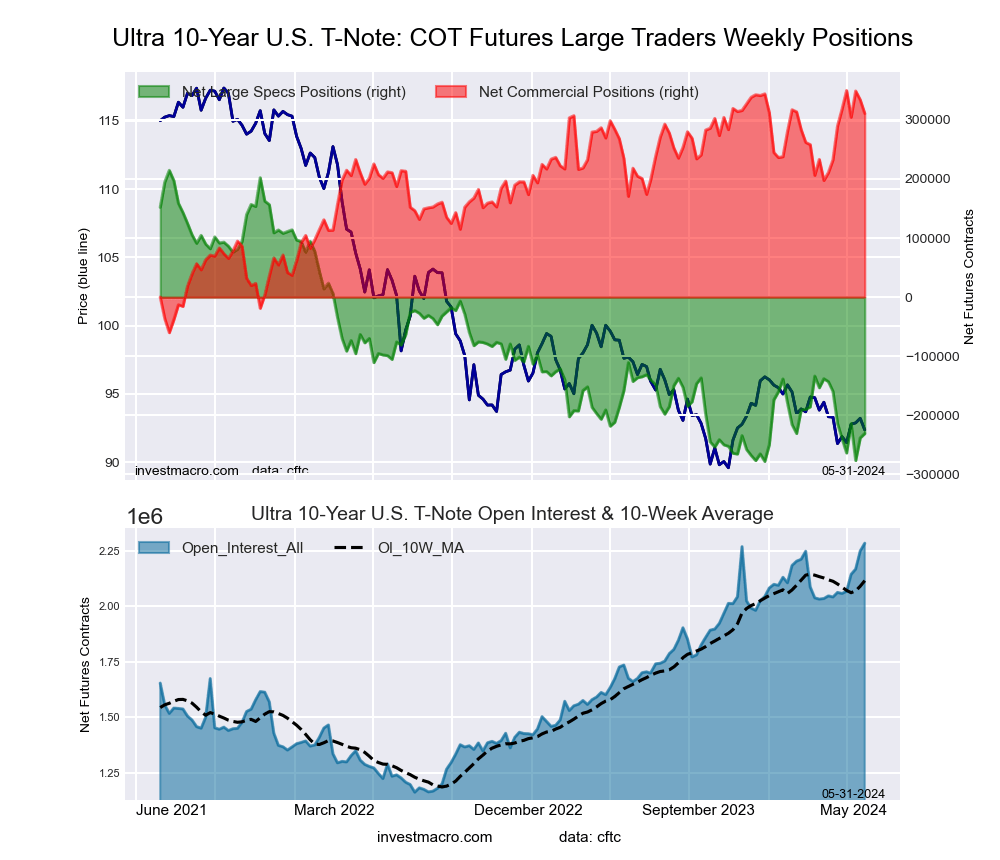 The Ultra 10-Year Notes large speculator standing this week came in at a net position of -230,765 contracts in the data reported through Tuesday. This was a weekly advance of 7,379 contracts from the previous week which had a total of -238,144 net contracts.
The Ultra 10-Year Notes large speculator standing this week came in at a net position of -230,765 contracts in the data reported through Tuesday. This was a weekly advance of 7,379 contracts from the previous week which had a total of -238,144 net contracts.
This week’s current strength score (the trader positioning range over the past three years, measured from 0 to 100) shows the speculators are currently Bearish-Extreme with a score of 9.6 percent. The commercials are Bullish-Extreme with a score of 90.5 percent and the small traders (not shown in chart) are Bullish with a score of 66.5 percent.
Price Trend-Following Model: Weak Uptrend
Our weekly trend-following model classifies the current market price position as: Weak Uptrend. The current action for the model is considered to be: Hold – Maintain Long Position.
| Ultra 10-Year Notes Statistics | SPECULATORS | COMMERCIALS | SMALL TRADERS |
| – Percent of Open Interest Longs: | 11.3 | 73.6 | 9.6 |
| – Percent of Open Interest Shorts: | 21.4 | 60.0 | 13.1 |
| – Net Position: | -230,765 | 310,709 | -79,944 |
| – Gross Longs: | 257,569 | 1,680,482 | 220,053 |
| – Gross Shorts: | 488,334 | 1,369,773 | 299,997 |
| – Long to Short Ratio: | 0.5 to 1 | 1.2 to 1 | 0.7 to 1 |
| NET POSITION TREND: | |||
| – Strength Index Score (3 Year Range Pct): | 9.6 | 90.5 | 66.5 |
| – Strength Index Reading (3 Year Range): | Bearish-Extreme | Bullish-Extreme | Bullish |
| NET POSITION MOVEMENT INDEX: | |||
| – 6-Week Change in Strength Index: | -3.5 | 5.2 | -2.5 |
US Treasury Bonds Futures:
 The US Treasury Bonds large speculator standing this week came in at a net position of 43,836 contracts in the data reported through Tuesday. This was a weekly gain of 29,660 contracts from the previous week which had a total of 14,176 net contracts.
The US Treasury Bonds large speculator standing this week came in at a net position of 43,836 contracts in the data reported through Tuesday. This was a weekly gain of 29,660 contracts from the previous week which had a total of 14,176 net contracts.
This week’s current strength score (the trader positioning range over the past three years, measured from 0 to 100) shows the speculators are currently Bullish-Extreme with a score of 98.8 percent. The commercials are Bearish-Extreme with a score of 0.0 percent and the small traders (not shown in chart) are Bullish with a score of 70.5 percent.
Price Trend-Following Model: Downtrend
Our weekly trend-following model classifies the current market price position as: Downtrend. The current action for the model is considered to be: Hold – Maintain Short Position.
| US Treasury Bonds Statistics | SPECULATORS | COMMERCIALS | SMALL TRADERS |
| – Percent of Open Interest Longs: | 16.4 | 66.8 | 12.1 |
| – Percent of Open Interest Shorts: | 13.8 | 71.4 | 10.1 |
| – Net Position: | 43,836 | -78,798 | 34,962 |
| – Gross Longs: | 278,502 | 1,131,701 | 205,371 |
| – Gross Shorts: | 234,666 | 1,210,499 | 170,409 |
| – Long to Short Ratio: | 1.2 to 1 | 0.9 to 1 | 1.2 to 1 |
| NET POSITION TREND: | |||
| – Strength Index Score (3 Year Range Pct): | 98.8 | 0.0 | 70.5 |
| – Strength Index Reading (3 Year Range): | Bullish-Extreme | Bearish-Extreme | Bullish |
| NET POSITION MOVEMENT INDEX: | |||
| – 6-Week Change in Strength Index: | 20.8 | -18.7 | -4.4 |
Ultra US Treasury Bonds Futures:
 The Ultra US Treasury Bonds large speculator standing this week came in at a net position of -318,068 contracts in the data reported through Tuesday. This was a weekly increase of 10,849 contracts from the previous week which had a total of -328,917 net contracts.
The Ultra US Treasury Bonds large speculator standing this week came in at a net position of -318,068 contracts in the data reported through Tuesday. This was a weekly increase of 10,849 contracts from the previous week which had a total of -328,917 net contracts.
This week’s current strength score (the trader positioning range over the past three years, measured from 0 to 100) shows the speculators are currently Bullish with a score of 57.6 percent. The commercials are Bearish with a score of 44.6 percent and the small traders (not shown in chart) are Bullish with a score of 50.6 percent.
Price Trend-Following Model: Downtrend
Our weekly trend-following model classifies the current market price position as: Downtrend. The current action for the model is considered to be: Hold – Maintain Short Position.
| Ultra US Treasury Bonds Statistics | SPECULATORS | COMMERCIALS | SMALL TRADERS |
| – Percent of Open Interest Longs: | 8.2 | 74.8 | 12.6 |
| – Percent of Open Interest Shorts: | 25.4 | 58.4 | 11.7 |
| – Net Position: | -318,068 | 302,721 | 15,347 |
| – Gross Longs: | 152,466 | 1,383,342 | 232,468 |
| – Gross Shorts: | 470,534 | 1,080,621 | 217,121 |
| – Long to Short Ratio: | 0.3 to 1 | 1.3 to 1 | 1.1 to 1 |
| NET POSITION TREND: | |||
| – Strength Index Score (3 Year Range Pct): | 57.6 | 44.6 | 50.6 |
| – Strength Index Reading (3 Year Range): | Bullish | Bearish | Bullish |
| NET POSITION MOVEMENT INDEX: | |||
| – 6-Week Change in Strength Index: | -9.7 | 4.9 | 13.2 |
Article By InvestMacro – Receive our weekly COT Newsletter
*COT Report: The COT data, released weekly to the public each Friday, is updated through the most recent Tuesday (data is 3 days old) and shows a quick view of how large speculators or non-commercials (for-profit traders) were positioned in the futures markets.
The CFTC categorizes trader positions according to commercial hedgers (traders who use futures contracts for hedging as part of the business), non-commercials (large traders who speculate to realize trading profits) and nonreportable traders (usually small traders/speculators) as well as their open interest (contracts open in the market at time of reporting). See CFTC criteria here.

- Markets rallied sharply on the back of a 90-day tariff postponement. China became an exception with tariffs of 125% Apr 10, 2025
- Pound Rallies Sharply Weak Dollar Boosts GBP, but BoE Rate Outlook May Complicate Future Gains Apr 10, 2025
- Tariffs on US imports come into effect today. The RBNZ expectedly lowered the rate by 0.25% Apr 9, 2025
- Volatility in financial markets is insane. Oil fell to $60.7 per barrel Apr 8, 2025
- Japanese Yen Recovers Some Losses as Investors Seek Safe-Haven Assets Apr 8, 2025
- The sell-off in risk assets intensified as tariffs took effect Apr 7, 2025
- COT Metals Charts: Speculator Bets led lower by Gold, Copper & Silver Apr 5, 2025
- COT Bonds Charts: Speculator Bets led by SOFR 1-Month & US Treasury Bonds Apr 5, 2025
- COT Soft Commodities Charts: Speculator Bets led by Soybean Oil, Cotton & Soybeans Apr 5, 2025
- COT Stock Market Charts: Speculator Bets led by S&P500 & Nasdaq Apr 5, 2025

